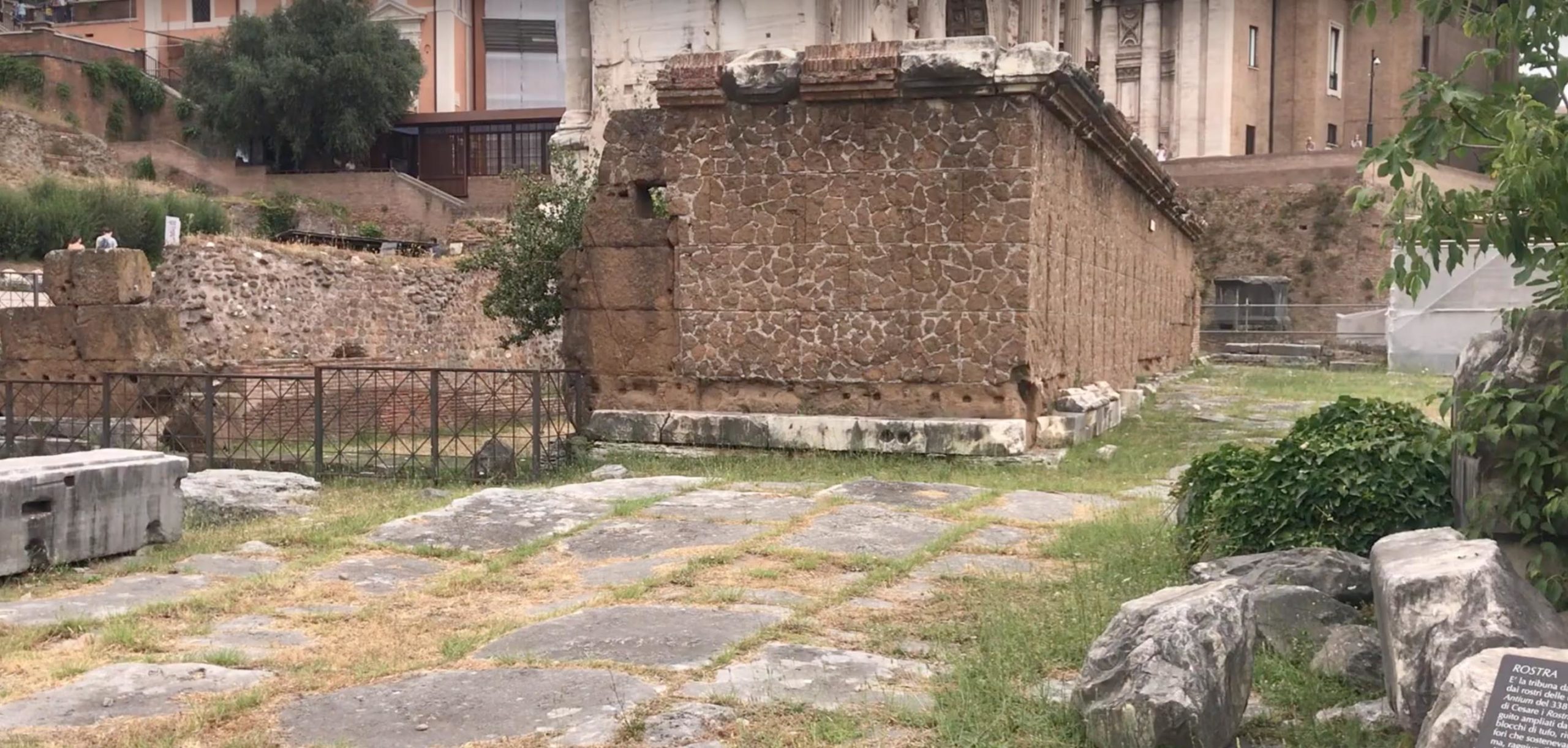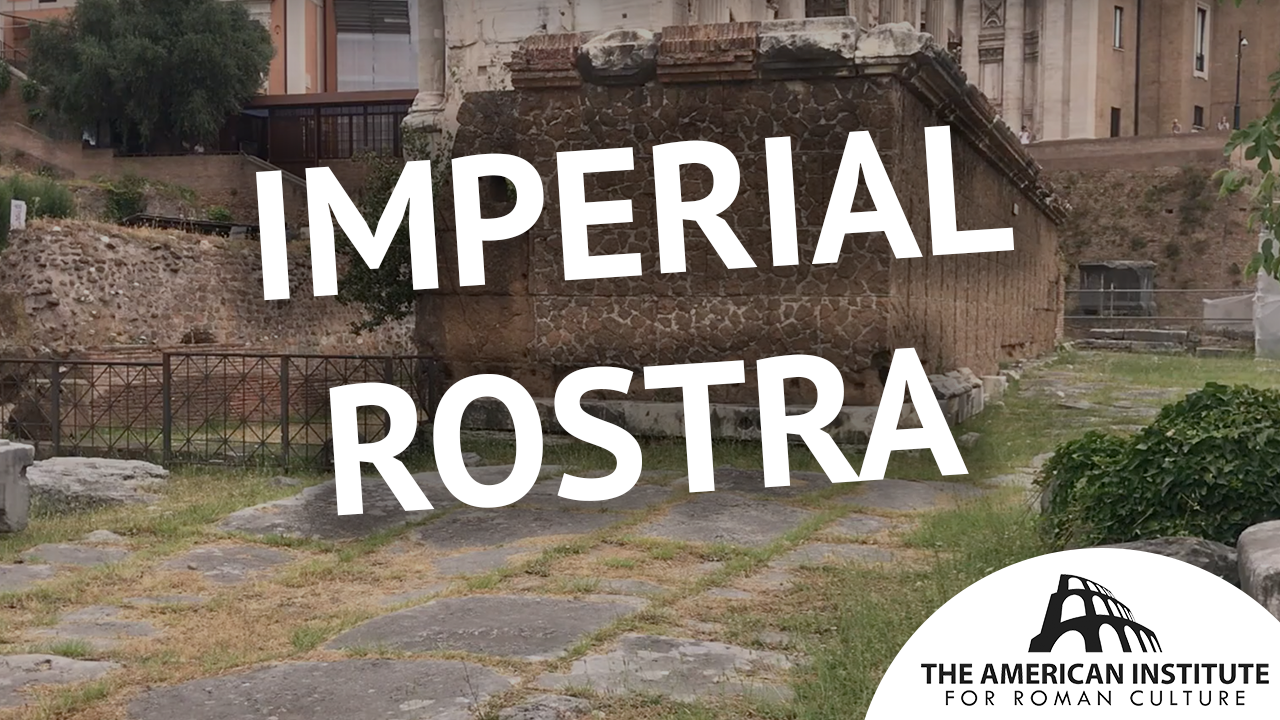Start with our video overview:
Read more:
(Cass. Dio xliii. 49; cf. Diod. xii. 26; Ascon. ad Mil. 12).1 If we consider the point at which Caesar’s body was burnt, it will seem natural that Mark Antony’s oration should have been delivered at the opposite end of the forum (cf. Senec. Dial. iii. I. 3: a rostris usque ad arcum Fabianum to express the whole length of the forum). Augustus completed them (Pomponius, Dig. i. 2. 2) and he is represented seated on the rostra in a coin (Cohen, Aug. 529 =BM. Aug. 115=HC p. 75, fig. 32). A funeral oration in honour of Augustus was delivered from this rostra by Drusus (Suet. Aug. 100, where it is called vetera in contradistinction to the Rostra aedis divi lulii).
Cassius Dio describes two magnificent ceremonies which took place on the rostra, the reception of Tiridates by Nero and the funeral ceremony of Pertinax (lvi. 34; lxxxiv. 3); cf. also Fronto ad Antonin. i. 2, p. 98, Nab.; Mamertin. genethl. Maximian. 19; Prudentius, Peristeph. xi. 45; Aur. Victor, epit. 19.
We know of the existence of statues in rostris of Augustus (Tac. Ann. iv. 67), where he speaks of the rostra elliptically ‘ celeberrimo fori,’ just as the old rostra had been called oculatissimus locus; and even Ammianus Marcellinus (xvi. 10. 13) calls it perspectissimum priscae potentiae locum; Claudius Gothicus (Hist. Aug. Claud. 3), and Stilicho (CILvi. 1731 = 1195). In a relief on the arch of Constantine (supra, p. 27) columns with statues standing upon them are, as a fact, seen behind the rostra.3
The existing remains of the rostra belong to four main periods: (1) that of Caesar, the concrete core of whose rostra, 3.50 metres high, is preserved for a length of over 13 metres, built against, and in all probability on top of, the line of arches supporting the CLIVUS CAPITOLINUS (q.v.).
(2) that of Augustus, who incorporated the core of the rostra of Caesar in a larger and higher core, which served as the foundation for the curved flight of steps on the west extending across the whole length of the rostra, and forming a monumental approach to the platform itself. The front of this enlarged core was faced with a wall of the finest Augustan brickwork; and a wall faced with the same material is to be found in the foundations of the north side of the platform itself, and possibly in the front also. The platform extended 10 metres forward from the western brick wall, and its front was about 24 metres in length and 3 high. The front and side walls are built of opus quadratum of tufa, faced with marble; bronze beaks in two rows were let into this facing. These walls have been restored by Boni up to their original height. The travertine paving slabs of the platform were supported by beams of the same material resting on these walls and on three rows of travertine piers, which were in later times partly replaced and partly strengthened by brick piers and walls. A marble balustrade extended along the sides and front, in the centre of which there was an opening.
The theory outlined above is confirmed by an interesting detail. The plans of the central area of the forum (HC p. 139, fig. 69; ZA p. 83, fig. 18) omit two more ‘ pozzi rituali ‘ of the line in the right bottom portion, which take it down as far as the front of the original rostra of Caesar. When the rostra were enlarged by Augustus, these two last pozzi, together with the first shown in the plan, were suppressed, and a new line created, which ran along the front of the new facade. (According to the theory previously current, it was to Trajan that the rectangular platform should be attributed.)
(3) that of Septimius Severus, in connection with the erection of whose arch most of the north wall of the rostra was removed, the north part of the back wall of brick-faced concrete cut down to the level of the pavement, and the so-called hemicycle formed by cutting back the brick-faced core of the steps for at least more than half its length, so that its curve should correspond with that of the flight of steps behind.
The northern half of the hemicycle was decorated with slabs of Porta Santa marble, with pilasters of africano at intervals, and a plinth of Pentelic marble, while a richly decorated curved cornice probably belonged to a colonnade along the front of it (Mitt. 1902, 18, fig. 3). The work was not completed at the southern end. A small triangular court was thus formed, from which steps led up to the platform (HC p. 77, fig. 33); and this and the space under the rostra were paved with tiles overlying an earlier pavement of herring-bone brickwork; some of them bear stamps of the Severan period (CIL xv. 405). According to an older theory, now generally abandoned, the hemicycle was the Graecostasis of the time of Caesar (Nichols, Notizie dei Rostri), while Mau held it to be his rostra (Mitt. 1905, 230-266; Richter, BRT ii.; iv. ii; Delbrftck, Hellenist. Bauten, ii. 89; BPW 1912, 1737).
(4) that of about 470 A.D. (?), when the rectangular part of the rostra was lengthened by a trapezoidal brick addition at the north end, the facade of which was also decorated with beaks. An inscription which ran the whole length of the enlarged platform recorded a restoration by the praefectus urbi, Junius Valentinus, in honour of Leo and Anthemius (?), possibly after a naval victory over the Vandals.
The two marble balustrades or plutei which now stand in the open area of the forum near the column of Phocas are generally supposed to have formed part of the rostra, standing either on each side of the approach or at the ends of the platform (for the latter, see HC p. 74, fig. 31; P1. p. 223, fig. 45). They were, as a fact, found where they now stand, roughly erected on blocks of travertine (Jord. i. 2, p. 219, pi. iv. fig. 3). They date, according to one view,4 from the time of Domitian (so Cantarelli in BC 1889, 99-113; 1900, 45; 1920, 169; cf. also SScR 138-142, 418); but most authors refer them to Trajan,5 and explain them as representing Trajan’s charity in providing for the support of poor children, by investment of large sums in mortgages on farms, and the destruction by his orders of the registers of taxes on inheritances already due. They have recently been assigned to the reign of Hadrian and attributed to the enclosure of the STATUA MARSYAE (q.v.) : see Mel. 1927, 154-183.
To topographers they are interesting mainly for the representation of the buildings of the forum in the background.
In the first relief (that facing down the forum) the emperor is seen on the rostra in the foreground. Then comes the temple of Vespasian (that of Concord was probably on the first section, which is lost), with six Corinthian columns, then the temple of Saturn, with six Ionic columns, and an arch of the Doric arcade of the Tabularium between them. Beyond are the lower arcades of the basilica Iulia; while the statue of Marsyas and a sacred fig-tree in an enclosure (both of which stood close by; see STATUA MARSYAE, FICUS, OLEA, VITIS) terminate the picture, as they begin the representation on the second relief, serving obviously as a point de repkre. After them comes a series of arcades, like those on the first relief, representing the basilica Aemilia; then the Argiletum; then the Curia with a broad flight of steps in front of it (after its restoration by Domitian), wrongly represented as having a facade of five columns; and finally a triumphal arch, probably situated on the clivus Argentarius, with the rostra in the foreground once more. The recurrence both of the rostra and of the Marsyas shows that the two reliefs were intended to form a complete circle; while the temple of Caesar and the temple of Castor and Pollux, which are not represented, are precisely those which the speaker would have had before his eyes. It is also to be noticed that the reliefs on the other (outer) side of each pluteus, representing the sheep, swine, and bull, the animals sacrificed in the suovetaurilia, are on quite a different scale, and easily visible from the level of the forum; whereas the reliefs on the inner side are on a much smaller scale, and only visible from close by (AJA 1901, 58-82; Mitt. 1889, 239-240; 1897, 326; Petersen in Abh. A. v. Oettingen gewidmet (1898), 130-143; HC 97-102; ZA 75-76). The relief of the suovetaurilia was imitated on the base of a column erected close by to commemorate the decennalia of Diocletian (CIL vi. 1204), for the reliefs of which see AJA 1914, 146-155; SScR 317, 318; HC 95, 96.
The theory that the reliefs belonged to a monument erected in honour of Trajan and represent only the buildings on the east side of the forum is due to a misinterpretation of a passage of Pliny (Panegyr. 36; cf. BPW 1906, 221; CR 1906, 132); while, according to another theory, this monument stood near the tribunal praetoris, and the reliefs represent the buildings on the west side of the forum (AJA 1910, 310-317).
For the rostra in general, see Jord. i. 2. 229 sqq.; Nichols, Notizie dei Rostri (Rome 1885); Richter, Rem. Rednerbfihne 8-39; Jahrb. d. Inst. 1889, 1-7; BRT ii.; HC 70-77; Mitt. 1895, 59; 1889, 238; 1902, 13-21; 1905, 15-28, 230-266; 1906, 57-63; AJA 1909, 170-186; RE i. A. 450 sqq.; CR 1899, 235; DR 359-38 ; HFP 22-25.
This content is brought to you by The American Institute for Roman Culture, a 501(C)3 US Non-Profit Organization.
Please support our mission to aid learning and understanding of ancient Rome through free-to-access content by donating today.
Cite This Page
Cite this page as: Darius Arya, The American Institute for Roman Culture, “Imperial Rostra (Rostra Augusti)” Ancient Rome Live. Last modified 06/12/2020. https://ancientromelive.org/imperial-rostra-rostra-augusti/
License
Created by The American Institute of Roman Culture, published on 01/17/2020 under the following license: Creative Commons: Attribution-NonCommercial-ShareAlike. This license lets others remix, tweak, and build upon this content non-commercially, as long as they credit the author and license their new creations under the identical terms. Please note that content linked from this page may have different licensing terms.



